The traditional grid is crying for help. With homes consuming more energy than ever, something needs to change. Smart home tech seems to be the answer. This movement promises to bring control back to our fingertips.
Empowering Smart Homes
Ever wish you could speak to your thermostat? Now you can. Smart tech allows you to take charge. As power bills climb, adjusting energy use is a game-changer. Smart homes make it easy.
Imagine your lights turning off automatically when you leave. Thermostats, lights, and appliances now talk to each other. This tech isn’t just flashy; it’s practical. With a smartphone or tablet, your home obeys. Energy savings become effortless.
And here’s the kicker: as a smart home user, you’re part of a growing movement. It’s not just about saving energy. It’s about shaping a sustainable future.
Smart plugs and outlets are another tool in the kit. These devices allow you to control non-smart appliances with ease. The convenience of turning any device on or off remotely adds to the home’s energy-saving arsenal. No more wondering if you left the iron on—efficiency at your fingertips.
Utilizing geofencing, smart homes know precisely when you’re coming or going. By aligning your home’s systems with your routine, energy-draining appliances switch off when they’re not needed, significantly conserving power while aligning comfort with daily habits.
For those living in bustling urban centers like Dallas, understanding local electricity offerings can be vital. Exploring Dallas electricity plans can provide options tailored to smart home users looking to optimize energy use and savings.
Beyond mere convenience, smart home integrations cultivate a sense of awareness among homeowners. Regular notifications on energy consumption patterns help identify potential wastages, encouraging proactive management and fostering an environmentally friendly lifestyle. This heightened awareness further encourages community-wide participation in energy conservation efforts, broadening the positive impact.

Game of Data
Smart homes thrive on data. Sensors collect everything, from power use to room temperature. This info is gold. It helps tweak settings, improve comfort, and save cash. Data ensures the optimal balance between usage and savings.
But with data, privacy concerns pop up. Is your data safe? Keep an eye on how your devices interact. Know what your gadgets are sharing and with whom. Your home, your rules.
Regular software updates patch vulnerabilities and update functionality, ensuring maximum protection and enhanced operations. Keeping devices up-to-date should be a priority, protecting both your data and prolonging device lifespan while staying ahead of potential cyber threats.
This data not only enriches the user experience but also plays a big role in guiding future innovations in smart home technology. Companies leverage anonymized data insights to refine products and make them more intuitive, ultimately contributing to an even more seamless integration into everyday life.
The Grid’s Best Friend
The energy grid needs a buddy. With demand soaring, stability is at risk. Enter smart tech. This partnership is about balance. At peak times, smart homes adjust to lighten the load on the grid. It’s doing your bit for the planet.
Homes generating their own energy feed excess back into the grid. It’s a two-way street. Solar panels and wind turbines might turn homeowners into energy suppliers. The grid gets support, and you get credits. Not a bad deal.
Battery storage systems bolster this relationship further. By storing power generated during low-demand periods, these setups unleash energy during peak times, reducing grid dependency. This buffer not only aids in stabilizing demand but also enhances resilience during outages.
Moreover, new collaborative initiatives are emerging, bringing neighborhoods together to share resources. Such community energy-sharing networks optimize resource allocation and foster neighborly collaboration in energy storage and consumption. This community-driven strategy not only curbs costs but also fortifies collective commitment to sustainable living.
Cutting Power While Boosting Comfort
Live in a hot zone? Seamlessly cool your home without cranking the AC. Smart fans and strategic window usage make a big difference. Comfort doesn’t mean waste.
Manage your surroundings for minimal power use. Strategically set heating or cooling schedules, and the savings start rolling in. Why waste energy if you don’t have to?
Smart home technology doesn’t just cater to temperature regulation. Enhanced light management systems also offer notable power reductions. Automated adjustments to blinds or curtains make full use of natural light, boosting mood and cutting costs—an easy method for maintaining comfort while compromising nothing.
Look to the Future
What’s next? Smart homes are evolving. We may soon see them sync with electric vehicles. Picture a unified system managing home appliances, EVs, and solar outputs. A connected living experience could redefine energy use.
The power is in your hands. Anyone can be part of the change. It’s time to embrace smart tech in homes and witness a dramatic reduction in grid reliance.
Conclusion
Smart home tech isn’t just the future; it’s here, reshaping grid dynamics. It empowers consumers, benefits our environment, and offers peace of mind. The grid is grateful for the support. Your wallet won’t mind either.
As we rethink energy consumption, remember this: the future is in our homes. It’s time to make every watt count.
